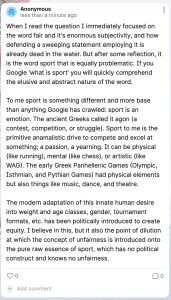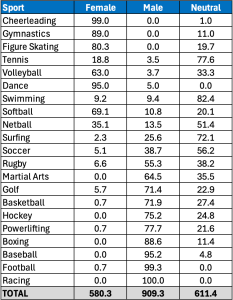2
Section One: The Fundamentals
A) History and Context
Exercise 1: Notebook Prompt
| a) There were surprising drops in the editing, for example in the introductory story in the podcast, there was no “world-record holder in Kenya.” Maximila Imali set the Kenyan record, not a world record. b) Storytelling is great entertainment, but as in all art forms, when the artifice becomes too obvious, it loses it’s appeal. c) The issue of intersex athletes is extremely complex and unsuited to theatrical media proselytization. |
B) Timeline of History
Exercise 2: Notebook Prompt
What other significant case/milestone would you add to this timeline? Note it in your notebook along with a brief (one or two sentences) explanation of why you feel it is important.
All pretty much speak for themselves. The changes or the past half-century seem like a lifetime, but against 1 & 2 they are a microscopic blip. The three athletes between 1932-39 are examples of a notable period of intersex competitors at the elite level during the depression. And Trump’s re-election policies after two weeks are already a marker of a tragic reversion in gender ideology which will impact both intersex and trans athletes (i.e. potentially denying them access to the country for the next Summer Olympics in L.A.). |
C) Gender coding in Sports
Exercise 3: Notebook Prompt
Has the gendering of sport ever been a constraint on your involvement? How?
Or, if not, why do you think this is?
| As an athlete, not really. The issue of intersex, gender fluid, and female athletes in men’s sport has had much less surfacing. I did get klobbered face-first into the boards from a girl in an intramural Trent hockey game once, but that’s about it.
As a male coach in female sport, in the past it hasn’t been an issue, but with the recent push for more women in coaching positions it has altered the equation from purely qualifications. How gender impacts coaching is another under-researched complex issue. |
D) How is sport gendered in the popular imagination?
Exercise 4: Padlet/Notebook Prompt
While most sports are in fact unisex, gender coding remains pervasive, particularly at the professional level, although with a foundation established in youth competition. Participate in the poll below to share your views on how popular sports are gendered in the popular imagination. Also feel welcome to add or suggest sports that you feel strongly conform to the gender binary!
After you contribute to the padlet prompt, record your response in your notebook AND briefly discuss in two or three sentences how these responses and the polling figures in general confirm or contradict your assumptions about gender-coding and sports. Did anything surprise you?
| I probably identify more of these as neutral than most people, in fact almost all of them. Even one’s that are typically codified as male or female like racing, boxing, football (male) and cheerleading, dance, softball (female) – I l know participants of the alternate gender. The results confirm my expectations of how others would react and rate. The media plays a large role in shaping our attitudes, for example, major professional sports like hockey, basketball, baseball, and soccer are heavily and abhorrently media-skewed towards male athletes. Our sport-tainment ecosystem and machine has been, and is, focused on male athletics. Female coverage exists, but it in many sports in a heterosexy way or going-through-the-motions manner, under threat of license suspension for lack of diversity rather than serious consideration.
An interesting observation is that when the current polls are aggregated to provide totals for all sport in general, males are 60% higher than females in gendered perception in this class.
|
Section Two: Breaking it down
A) Title IX
Exercise 5: Notebook Prompt
In a longer version of the interview excerpted in the video above, Leah Thomas states “Trans women competing in women’s sports does not threaten women’s sports as a whole because trans women are a very small minority of all athletes and the NCAA rules around trans women competing in women’s sports have been around for 10+ years and we haven’t seen any massive wave of trans women dominating”?
Do you agree with this statement? See also the image above suggesting that the issue may be overblown by politicians and influencers who don’t actually care that much about women’s sports.
Please share any thoughts you have in your Notebook by clicking on the audio button above or writing a few sentences.
| Statement 1: Trans women competing in women’s sports does not threaten women’s sports as a whole because trans women are a very small minority of all athletes.
This is mathematically true but at the same time is a bit of straw man and reminds me of the argument that killing one person is justified if it benefits a larger number (which is also mathematically true). But it is of course false in that it violates the sanctity of human life. Similarly, the number of trans athletes is merely one of many inputs into a larger equation; truth, justice, and fairness are more about ethics, principles, philosophy, morality and values than math. Statement 2: NCAA rules around trans women competing in women’s sports have been around for 10+ years and we haven’t seen any massive wave of trans women dominating. I think we are at a Jackie Robinson point in time. When it comes to trans athletes it would be naive to think the past/future is linear, or that historical results represent a form of truth. Historical context also casts a cautionary and foreboding note. In the mid-20th century Russia used to forcefully take five year-old girls away from their families and send them to gymnastics factories to be mass-produced into champions of the motherland. Next, fast-forward to the massive and comprehensive state-sponsored doping labs in Socchi. There is little to suspend belief bad nation-state actors will push every well-meaning gender envelope and game every opportunity. Success in international sport is a powerful propaganda tool and drug employed by dictators and authoritarians, and unchecked, will definitely lead to flagrant abuses..
|
B) Unfair Advantage?
Exercise 6: Notebook Prompt
What does the host and writer, Rose Eveleth, have to say on the issue of unfair advantage?
Can you think of other examples of unique biological or circumstantial advantages from which athletes have benefitted enormously that have nothing to do with gender?
| Question 1: What does the host and writer, Rose Eveleth, have to say on the issue of unfair advantage?
If you read between the lines, Eveleth does not believe DSD athletes have an unfair advantage. There is a shortage of reliable research on DSD athletes. We celebrate genetic difference unless it is sex-based. Fairness is not scientific and just data science, it is human and ethical as well. Question 2: Can you think of other examples of unique biological or circumstantial advantages from which athletes have benefitted enormously that have nothing to do with gender? Height in basketball, weight in Sumo, IQ in chess, hereditary genetics in most sport (like million-dollar stud fees of prize-winning thoroughbreds), wingspan, torso size and hand/foot size in swimming, Lance Armstrong’s VO2 Max, etc.
|
Again, let’s turn to Katie Barnes who points out that we tend to forget amidst all the debate that “sports, by design, are not fair” (235), that “the reality of sports is that we accept unfairness all the time” (235).
Do you agree? Why? In your experience, how fair are sports? Feel welcome to add a video response in the padlet and provide an example if you’re willing. Make sure you include a screenshot of your response in your notebook.

|
B) The Paris Olympics
Optional Response:
What does Robins mean when she argues that:
“The aims of transvestigating an Olympic athlete are not, in any meaningful sense, anything to do with sports, or fairness, or even with women (cis women, at least) as a social category. Rather, they have everything to do with transness, and the public expression of transfemininity.
For my money this has never been about sport.
What it has always been is an excuse to publicly relitigate the existence of trans women.”
Make a note in your Notebook.
| Imane Khelif is a cisgender Algerian female boxer who is not trans and does not identify as intersex. She competed in the Paris Olympics and won gold. Khelif had previously been tested by the International Boxing Association and found to have a competitive advantage over other females. The details of this testing are vague and reportedly flawed. She was allowed to compete by the IOC on the basis of being born and registered female, and living her life as a female. She has not been tested for genetic variations or testosterone.
Roberts argues that Khelif’s case has nothing to do with sport and has been insidiously misappropriated by the anti-trans movement and billionaire activists. Which it clearly has. And while Roberts is simply pointing out an injustice and attempting to balance the narrative, at the same time they are guilty of the same weaponizing of a single case to advance a broader agenda. Which is both paradoxical and strangely symmetrical. |


